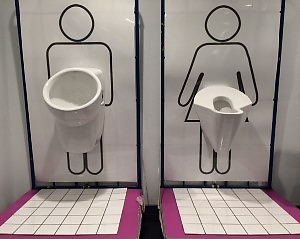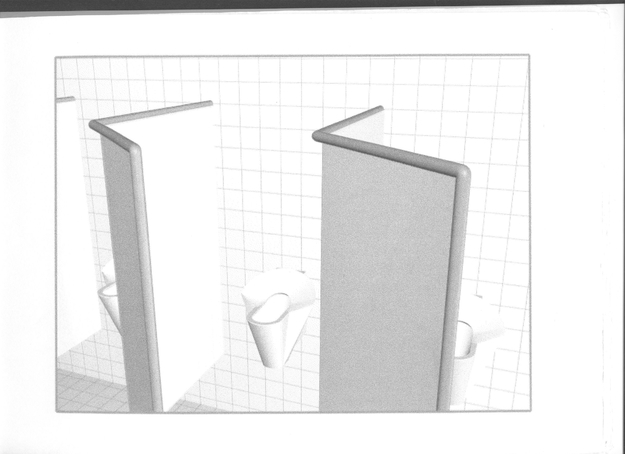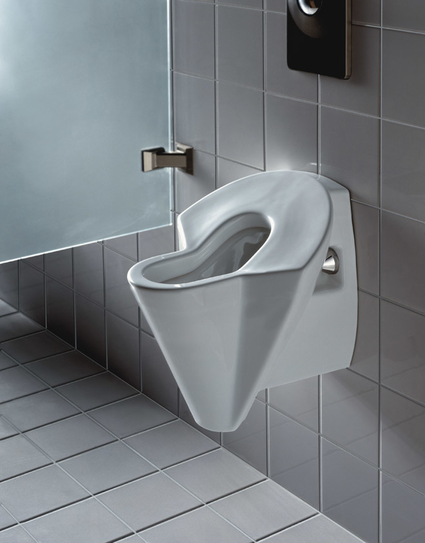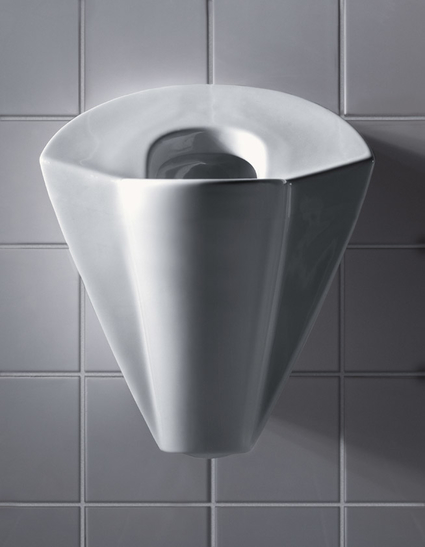The lady p made its appearance in 1999 as the brainchild of Marian Loth, a Dutch design engineer in Delft. It was produced by N.V. Royal Sphinx Gustavsberg and was meant to provide women with a comfortable solution to the unpleasant experience of going to a public restroom.
lady p - The female urinal designed by Marian Loth and produced by Royal Sphinx
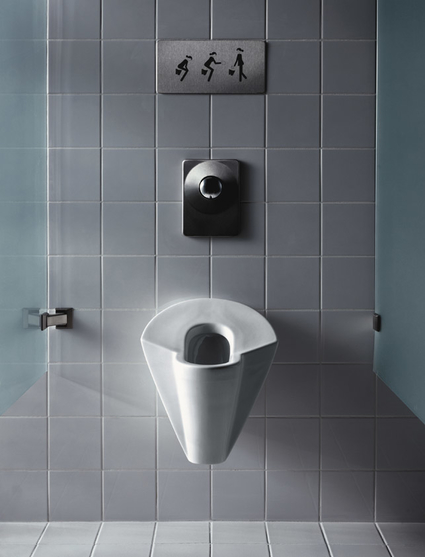
As a matter of fact, in ladies' toilets the waiting lines are normally very long, the stalls insufficient in number, small in size and often dirty, the seats sprinkled. According to one description of the product, Ms. Loth had the idea after seeing a friend resorting to a male urinal due to the long queue in front of the ladies' bathroom. She got involved in the topic and started researching practices and feelings women have when they go to public restrooms.
One of the findings was that almost every woman tries not to touch the seat and hovers over it instead in order to avoid germs. Thanks to the ergonomic shape of lady p (and the possible addition of a stabilising handrail), women still had to hover over the bowl, but did not risk to touch it and could more easily pee from a higher position simply standing with their back to the wall. For this reason, the lady p was supposed to be more hygienic than standard models. Moreover, it was meant to favour a faster use avoiding overcrowding. Indeed, each urinal had to be separated from the others through a wall with a bend, but none would have had a door.
In this way, women were psychologically pushed to just pee and leave rather than taking their time. At the same time, however, a certain degree of privacy was maintained and normal toilets in cubicles would have been available for other functions, such as menstruation and defecation. The absence of doors between urinals was considered unproblematic by Loth, who was confident in an open solution considering that women are generally close to one another. However, Royal Sphinx installed the lady p in normal cubicles using a frosted-glass partition. Such a change in the original design of the space made the advantage of this urinal type disappear and decreased privacy too much: contrary to the expectations, many women seemed then reluctant to choose the lady p instead of a classical closed stall. This issue hindered the diffusion of the urinal and eventually led Royal Sphinx to withdraw the model.
This anecdote is interesting for our work too, considering that we are looking into gender-related issues concerning public urination. This has already brought us to review female portable urination devices and to imagine the creation of a collective pissing room in Roman-style for women. There are a few things left for us to learn from Loth's innovative idea. First of all, we have to consider that women might prefer an enclosed solution that allow them to have more privacy. It would be interesting to experiment with a toilet stall that covers the body, but does not cover the face, in order to protect one's discretion, yet play with partial publicity in order to facilitate a speeding-up effect. At the same time, the collectiveness of the restroom may create a feeling of safety. Maybe it would be worth adopting Ms. Loth's original spacial concept and separating the toilets using a wall with a bend. The relation shape-function has to be taken into account too: the toilet should be comfortable and easy to use with any kind of clothing and it should prevent unwanted back-splashes. All in all, there is always room for improvement and the importance of creating a good environment becomes apparent if we think about the fact that most of our best ideas come from the small place where we find a relief from physical as well as social pressure.
As a manager of innovations at Royal Sphinx, Marian Loth has kept on working to improve traditional restrooms' structures, for example by developing a bathroom that fits the needs of elderly people. In the frame of Hygienic Train Toilet, her PhD project at TU Delft, she has focused on enhancing the design of train toilets and creating spaces that every person, no matter their sex, age, and possible physical limits, feels welcome (and safe) to use. The university website tells us that “[t]o make the train toilets better a urinal for men is added in the train toilet. Besides in this wheel-chair accessible train toilet extra grab handles, family-elements (toddler platforms and diaper changing table) are added”.
